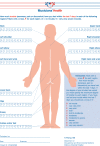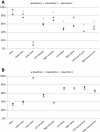Occurrence and co-existence of localized musculoskeletal symptoms and findings in work-attending orchestra musicians - an exploratory cross-sectional study
- PMID: 23025290
- PMCID: PMC3515426
- DOI: 10.1186/1756-0500-5-541
Occurrence and co-existence of localized musculoskeletal symptoms and findings in work-attending orchestra musicians - an exploratory cross-sectional study
Abstract
Background: Due to ergonomic exposure musicians are at risk of work-related musculoskeletal disorders in the neck, back, and upper extremities. The literature confirms musculoskeletal problems in these anatomic regions among orchestra musicians.
Methods: An explorative cross-sectional study among 441 musicians from six Danish symphony orchestras; 216 underwent a clinical examination constructed for the purpose. Prior to the examination the musicians rated their maximally perceived trouble within the last week on a scheme blinded to the examiner. Accessibility to the clinical examination differed between orchestras.The aims were to assess the prevalence of 1) perceived symptoms within the previous week in the neck, back and limbs and of 2) clinical findings in the neck, back, and upper extremities, and 3) to investigate the co-existence of the perceived symptoms and clinical findings.
Results: Symptoms and findings were most common in the neck, back, and shoulders. Due to a poor co-existence between self-reported symptoms and clinical findings musicians experiencing bodily trouble could not be identified through this clinical examination. Free accessibility to the examination was of major importance to participation.
Conclusions: In compliance with the purpose, perceived symptoms within the previous week and present clinical findings were assessed. Although both symptoms and findings were most frequent in the neck, back, and shoulders the co-existence of anatomically localized symptoms and findings was generally quite poor in this study.Discrepancy between symptoms and findings might be caused by the participants currently attending work and therefore being relatively healthy, and the fluctuating nature of musculoskeletal problems. Furthermore from a comparison of different measuring units - self-reported symptoms being period prevalence rates and clinical findings point prevalence rates; a bias which may also be inherent in similar studies combining self-reported questionnaire data and clinical findings.
Figures


References
-
- Nyman T, Wiktorin C, Mulder M, Johansson YL. Work postures and neck–shoulder pain among orchestra musicians. Am J Ind Med. 2007;50:370–376. - PubMed
-
- Foxman I, Burgel BJ. Musicians health and safety: Preventing playing-related musculoskeletal disorders musculoskeletal disorders. AAOHN J. 2006;54:309–316. - PubMed
-
- Turner-Stokes L, Reid K. Three-dimensional motionanalysis of upper limb movement in the bowing arm of string-playing musicians. Clin Biomech. 1999;14:426–433. - PubMed
-
- Edling CW, Fjellman-Wiklund A. Musculoskeletal disorders and assymetric playing postures of the upper extremity and back in music teachers. Medical Probl Perform Artists. 2009;24:113–118.
-
- Norris RN. Applied ergonomics: adaptive equipment and instrument modification for musicians. Md Med J. 1993;42:271–275. - PubMed
Publication types
MeSH terms
LinkOut - more resources
Full Text Sources
Medical

